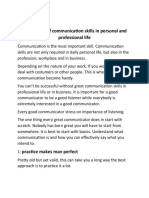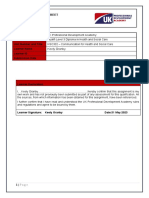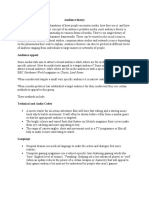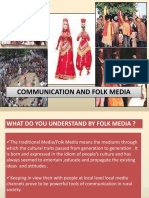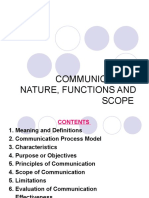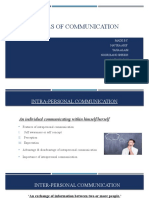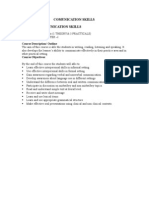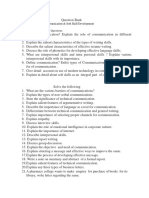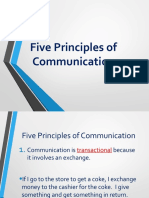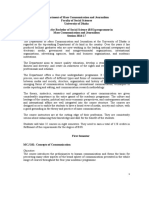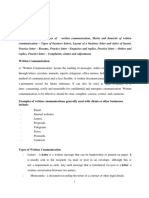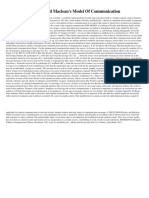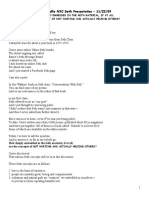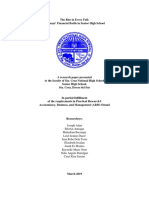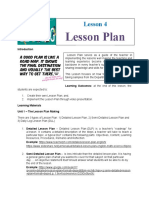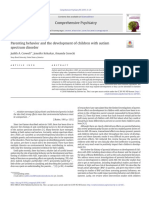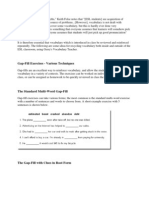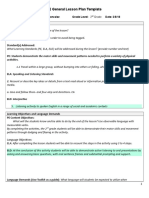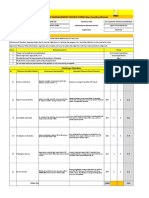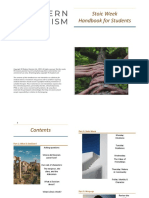Communication Foundations
I. Multiple Choice Questions
1. Communication is generally defined as
a. that which is received by another
b. knowledge, feelings and thoughts that are encoded
c. verbal and non-verbal behaviours perceived by another
d. human experiences transmitted via a channel
2. Meaning is primarily given to messages by
a. the originator of the message
b. the receiver of the message
c. both originator and receiver in equal proportions
d. feedback between originator and receiver
3. Communication is effective only when
a. individuals are open to receiving messages from others
b. it makes connections with others
c. individuals are good listeners
d. it achieves the intended outcome
4. Employers expect their employees to communicate in a
a. clear, purposeful, supportive and flexible way
b. strong and aggressive manner
c. controlling way
d. creative, unplanned and indirect manner
5. What are the different types of communication?
a. intrapersonal, interpersonal, public and mass
b. individual, group, rational, international
c. employee, employer, media, online
d. all of the above
6. The result of clear messages by leaders, managers, team leaders and
members in an organisation is
a. clarified expectations and elimination of confusion
b. improved motivation and performance
c. their application across all mediums in business
d. an increase in the organisation’s efficiency
7. In contrast to academic writing, business communication requires particular precision, clarity and
efficiency because of
a. the pressure of time
b. new employees
c. the various mediums of communication
d. the need for a two-way approach
8. What messages do telecommunication services transmit?
a. Written
b. Voice
c. Data
d. All of the above
1
�9. Advances in technological improvements will
a. allow social networking through mobile devices to increase rapidly
b. integrate the internal and external world
c. improve non-verbal communication skills
d. help reconnect buyers and sellers
10. Information technology allows an organisation to apply its knowledge
systematically so that
a. individuals know how to use the technology efficiently and effectively
b. technology can release communication barriers
c. relevant data is on hand for decision making
d. technology is a replacement for the interaction and support provided by
interpersonal contact
11. Effective business communication bridges the different perspectives of individuals
a. within an organisation
b. nationally and globally
c. outside an organisation
d. all of the above
12. In today’s rapidly changing business environment you will be expected to show
a. initiative and enterprise
b. ability to follow instructions
c. ability to take time to think
d. what the employers demand
13. The difficulty for leaders and managers is to communicate in a way that achieves
a balance between
a. control, motivation and efficiency
b. male and female employees
c. clients and company
d. consumers and investors
14. Possible differences between the needs of an organisation or its employees are
a. who serves and who is served
b. competitiveness and challenge which employees are facing
c. employee efficiency and fringe benefits
d. all of the above
15. The outcome of effective two-way communication outside an organisation is
a. short-term relationships built on profit margins
b. long-term relationships built on collegiality
c. long-term relationships built on trust and goodwill
d. short-term relationships built on mutual benefit and risks
16. A communication model is a representation of the main elements in the message flow process
which has been
a. simplified
b. specified
c. theorised
d. communicated
2
�17. Encoding the message when communicating is initially done by
a. the sender of the message
b. the medium used to capture the message
c. the receiver of the message
d. an interplay between sender, receiver and the medium selected
18. Every communicator brings to their communication with others
a. knowledge, skills and attitudes
b. verbal and graphic techniques
c. current experience of communication
d. a unique combination of cultural conditioning, skills, attitudes and experiences
19. A significant influence on the effectiveness of communication is
a. level of economic development in a country
b. the speaker’s fluency in English
c. the way the message is perceived
d. a successful utilisation of graphic communication skill
20. Feedback in any communication is
a. essential
b. able to be withheld or hidden
c. useful but not critical
d. unavoidable
21. Which of the following statements is correct?
a. Feedback is always intentional.
b. Feedback reduces continuity in communication.
c. Feedback prevents senders from measuring the effectiveness of their
communication.
d. Feedback increases the amount of time needed to send the message.
22. The purpose of feedback is to
a. assist in the development of effective working relationships
b. increase the accuracy of the message in the communication climate
c. improve the communication skills of the receiver
d. achieve agreement between all parties
23. Communication channels are
a. journals, books and magazines
b. means or techniques used to signal or convey a message
c. visual, verbal, non-verbal
d. both a and c
24. Within an organisation messages are sent and received
a. through emails exclusively
b. through informal communication channels only
c. by a formal channel exclusively
d. none of the above
25. The context of communication refers to
a. the presence at the communication event of individuals previously associated
with it
b. physical, social and gender conditions
c. physical, social and temporal conditions
d. the past background to the communication event
3
�26. Communication barriers are likely to lead to
a. harmonious relationships
b. misunderstanding
c. encoded communication
d. clear understanding of the messages
27. Communication barriers are often caused by
a. the sender or the receiver
b. appropriate choice of words
c. a suitable channel
d. receiver attention
28. “The message received is not necessarily the same as the message sent” refers to the general
impact on communication of
a. less than adequate feedback
b. communication barriers
c. poor choice of communication channels
d. ignoring the importance of context
31. The transactional nature of communication is
a. an exchange where we share understandings and use feedback to attain our
purposes
b. a transaction where we invent and attribute meanings to what we perceive to
realise our purpose
c. a transaction where we receive meaning through repetitive loop exchanges
d. non-linear repetitive interchanges focused on the messages and the context in
which those messages are transacted
32. Communication is essential in helping individuals to
a. live in isolation
b. co-create a social reality
c. depend on personal and interpersonal meaning
d. develop, control and sustain their contacts with others
33. Interpretation of the same message may vary between individuals depending on their perceptions
because they are influenced by
a. discrimination against women
b. the personalities of the sender and receiver
c. experience, attitudes, beliefs and a range of acquired skills or expectations
d. the communication skills of the sender
34. Senders and receivers are able to communicate more effectively in terms of
different cultural diversities by
a. understanding different rules for the use of humour, irony and courtesy
b. perceiving the intended message
c. understanding their own cultural filter and accepting other cultural filters
d. identifying dimensions in the context
35. The temporal dimension
a. contains the tangible or concrete items in the environment
b. means the roles, norms and mores of the society
c. consists of different languages, relationships and authority to achieve the
different communication purposes
d. describes the time in history as well as the position of the communication in the
sequence of events
4
�36. The key to understanding meaning in communication is
a. diversity of communication
b. situational context
c. relationship and authority
d. purpose of communication
37. In view of the gap between intent and effect, communication should not be taken for granted
because
a. the message sent is often quite different from the message received
b. barriers arise when the sender assumes that the receiver will automatically
understand the message
c. we can learn more from listening than talking
d. we can recognise different kinds of unspoken messages
38. Empathy refers to
a. being supportive, non-judgmental and assertive
b. the ability to understand how the other person feels
c. supporting the other’s point of view and giving feedback
d. recognising and responding to the rational aspect in messages
39. Appropriate ethical behaviour is important in business because
a. organisations conducting business in an ethical way enhance their prospects of
survival and growth
b. there is a community expectation that businesses will act in an courteous way
c. surveys show that business ethics and good, ethical communications are less
valued
d. all of the above
40. Ethics can be defined as
a. criminal legislation
b. organisational ownership
c. cultures of staff
d. community based standards of right and wrong
41. The purpose of ethics is to
a. deal with customers quickly
b. get away with unlawful or improper behaviour
c. make ‘right’ decisions
d. be good at the technical side of the job
II. True/False Questions (25)
( ) 1. Communication is best defined as human experiences transmitted by the spoken word via a
channel.
( ) 2. Experience cannot be transmitted as experience—it must first be translated into something else.
( ) 3. Intrapersonal communication creates a person’s self-concept and processes information.
( ) 4. Individuals learn more about self, others and situations because they have a plan to absorb new
ideas and initiate action.
( ) 5. Individuals can do a great deal to influence another person’s perception, outlook, values and
5
� attitudes.
( ) 6. Business communication is different from academic or literary writing and speaking.
( ) 7. The purpose of an audience-centred approach is to provide ideas and give feedback to enhance
understanding.
( ) 8. Communication by mobile devices is a hindrance to those businesses with staff who are working
remotely or travelling between organisations and their clients.
( ) 9. What is driving the economy is not only information but also the knowledge of how to use it.
( ) 10. Social network services are primarily Web-based and offer various ways for users to interact:
discussion groups, messaging, chat rooms, email, videos, blogging and file sharing.
( ) 11. Any organisation is a collection of people who all have similar backgrounds and life and career
experiences.
( ) 12. Leaders and managers with the capacity to communicate effectively are able to work directly with
people.
( ) 13. The more management controls, the more productivity and security for staff.
( ) 14. One of the biggest emerging challenges for local, national and global business is the need to look
after the interests of business owners.
( ) 15. The purpose of communication models and diagrams is to explain and classify every feature in the
process.
( ) 16. The receiver hears, reads or looks in order to encode the message.
( ) 17. An appropriate channel suits the communication purpose, the needs of the sender, the message
and receiver.
( ) 18. Diagonal channels of communication are normally used for day-to-day reporting to one’s
supervisor.
( ) 19. The message received is always the same as the message sent.
( ) 20. Time factors such as the present, transitory or temporary nature of the context within which the
communication occurs make up the temporal dimension.
( ) 21. Words convey the same meaning to all individuals in every culture.
( ) 22. Effective communication works only within the rules, norms and values and takes place within
current practices and formal and informal communication channels.
( ) 23. The communication process is two-way and takes place in many
situations, for one reason and with the possibility of many interpretations.
( ) 24. In view of the gap between intent and effect, communication should be taken for granted.
( ) 25. Ethical constraints affect the way we think about what is wrong and the way business is
conducted.




















